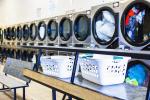GLENDALE, Ariz. — A great location; a large, clean laundromat with modern, high-functioning machines; convenient hours; and competitive prices can be the foundation of self-service laundry success. But what if your mat doesn’t check all those boxes? Well, you can compensate somewhat by appealing to your area’s differing demographics.
Since laundromats are open to the public, there are different “slices” of population that you can appeal to. Yes, the vast majority will respond favorably to the store I’ve described, but be aware that there is no “one size fits all.”
Certain customers respond differently than others because they may have different needs, and you could be missing out on attracting them. Here are some population shares to be aware of:
“Clean Freaks” or “Germophobes” — Some people fall into this category, especially nowadays, due to a heightened awareness of COVID-19. Even before the pandemic, we offered customers the use of spray bottles filled with isopropyl alcohol. They happily sprayed the inside of their washers, laundry carts and countertops before use. By sanitizing anything they wanted, it gave them a sense of control and protection.
Customers who were habitual hand-washers were basically locked in by this little complimentary convenience and by our clean sinks, restrooms and overall store.
Isopropyl alcohol is not a gimmick; it really does kill bacteria and viruses. Just make sure you get 70%. Results may not be as effective if you get a different percentage.
Customers with Big Laundry Loads — If you want to attract families who have lots of big loads of laundry, then make sure you have lots of big washers and dryers! The old 60-pounders are good, especially if you have several, but if you really want to stand out from your competitors, consider 80- or 100-pound machines. And have the dryers to match, as well as big laundry carts.
(Important tip: Install at least two of the big boys if you have the room. If you only have one and it goes down, emergency!)
Big equipment makes your mat stand out, and it gives you something great to advertise and promote. Customers who use these machines often come with trucks or SUVs, so your parking lot should also be able to accommodate them.
I had a few customers who would show up in vans, open the side door, and proceed to carry in eight or nine big bags of laundry. They often went straight to my biggest washers. It wasn’t just because they were more convenient for them to use, they knew that on a pound-for-pound basis, big washers cost them less.
These customers along would spend close to $100 each visit. They liked to come when it wasn’t busy, so it helped to have extended hours so they could find enough vacant machines to suit their needs. Large folding tables were a must, too.
And customers who have big loads often have big families, so it pays to offer a “Kiddie Korner” to attract their children and keep them occupied so the parents could concentrate on getting their laundry done.
Sub-groups of Customers — If you want to fill in your slow days (which for us was usually a Wednesday), it pays to offer a discount on that day for seniors, the military and first responders.
Customers Who Work Alternate Shifts — Many people work late hours or alternate shifts. You may want to consider opening early, staying open late, or even being open 24/7.
Being open around the clock not only attracts shift workers, but believe it or not, you’ll also do more business during the day. Why? It’s easier for people to choose a 24/7 mat simply based on the need to not have to memorize or look up operating hours. It’s well known that people will choose the path of least resistance. Being open 24/7 gives them simplicity and peace of mind (plus eliminates any arguments at closing time).
All Ethnic Groups Welcome — Many neighborhoods have residents from multiple ethnic groups these days. The times of serving English and Spanish customers alone are waning. Learn what languages are spoken in your mat’s neighborhood and make an effort to accommodate those ethnic groups with some multilingual signs. (One of my mats had signage in English, Spanish, Korean, Chinese, Farsi and Russian.)
Try to hire a mix of people who can match your area’s ethnic makeup. People usually feel more at home patronizing a store where there are employees from their own country. It may be ethnocentric, but that’s human nature, so why not work with that? Just don’t exclude any other ethnicity or group who may need a job. That’s wrong, and it’s illegal.
When the Chinese began to move into my New York City mat’s neighborhoods, I personally had communication problems. I could speak English, Italian, even a little Spanish, but I never learned to speak Chinese. Even a good day, Chinese customers rarely acknowledged me, even though they knew I was the owner. It’s wasn’t until I hired a great Chinese woman that they started responding. This employee told me that they asked if I was a good boss, and she told them she was happy to work for me. Lo and behold, after that, not only did they acknowledge me, they started smiling at me! I responded by learning some simple phrases in Chinese and how to count money in the language for them; it was a win-win.
For those customers who spoke a language no one on my staff could, we could use our cell phones to translate! That was a game changer, and of course, the customers felt much more comfortable about using our mat.
Check back Thursday for the conclusion!
Have a question or comment? E-mail our editor Bruce Beggs at [email protected].










